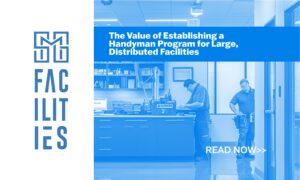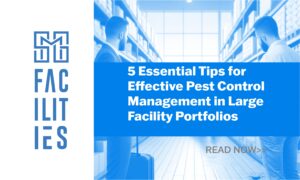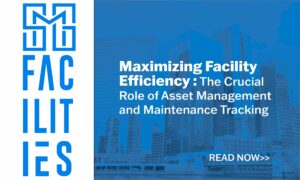With an overabundance of tasks in a world becoming more hectic by the day, facilities managers have to juggle their time and countless concerns — from asset management across a diverse portfolio, to working with growing number of suppliers, to implementing new projects enterprise-wide. In addition to that, facility professionals are tasked with managing preventive maintenance programs for many critical assets. These programs can be a handful for even the most competent and dedicated managers. But the good news is that this is where an outsourced service provider can save the day. It can help create a preventive maintenance strategy and program, implement, and execute it so the facilities manager meets their desired outcomes.
What are Preventive Maintenance Programs?
Let’s begin with what preventive maintenance means. Preventive maintenance or “PM” , is upkeep routinely performed on assets to reduce the likelihood of equipment failure and the costly unexpected downtime that can come with it. With real-time data insights, often with software like a computerized maintenance management system or CMMS, upcoming care can be planned and scheduled. These maintenance tasks can be performed while the equipment is still in working order to prevent unexpected breakdowns. Determining goals, measuring key performance indicators, setting up preventive maintenance triggers, and training staff to perform the care are all part of creating a preventive maintenance plan.
Another form of maintenance is predictive maintenance. Like preventive maintenance, its goal is to keep equipment working smoothly before anything goes wrong preemptively, but it has a different, more specific approach. While preventative gives you a ballpark of when to service machines, predictive maintenance uses “actionable” data derived from the CMMS and historial repair and maintenance (R&M) records to find anomalies and possible defects in equipment so they can be proactiively fixed before they result in a shutdown.
If you took your home, for example, preventive maintenance would be like changing your air or HVAC filters every few months. Predictive maintenance is like having a software system that tells you what exact dates those filters should be changed for optimal usage. Predictive maintenance could alter those dates based on changes indicated in the “actionable” data.
Challenges, Limitations of In-House, Nationwide Preventive Maintenance Programs
Nationwide preventive maintenance programs have ways to help you stay ahead of the game and, hopefully, ahead of disastrous breakdowns. But there are plenty of places where even those programs can come up short. Let’s look at some of those instances:
- The facilities manager lacks the knowledge and expertise to develop the strategy and program, or they need to focus on other, more important work to achieve company objectives. This can ruin any program almost before it even starts.
- The in-house team lacks time to handle routine tasks. It doesn’t help to have a system if the key steps are not followed.
- The facility management team cannot determine whether the plan is working. To know a successful program, there must be a way to verify its merit.
- The facilities manager can’t easily manage multiple service providers for the assets that need preventive maintenance across a nationwide footprint with multiple facilities, like chain food restaurants.
- The facilities manager doesn’t know how to verify work was done and completed as expected. All maintenance programs need information that substantiates the need for the program.
Why Use Outsource Preventive Maintenance Programs?
If your equipment is poorly maintained, it will result in eventual problems down the road. To avoid those road obstacles, the best approach is to partner with an outsourced preventative maintenance program. Here are some reasons why you can stay on course with outsourcing:
- Outsourcing Provides Expertise And Resources: Many pieces of equipment need an expert to ensure they are working correctly or where fixes need to be made. Most companies don’t have those experts or the resources to fix or alter that equipment.
- Outsourcing Helps Keep Everyone Safe: Accidents can happen in any business, but having in-form, well-maintained machinery that an expert has examined reduces safety concerns.
- Outsourcing Helps Gain Operational Efficiencies: With help from the proven processes of an outsourced provider, facilities managers can more efficiently stay on top of what machines need to be maintained.
- Outsourcing Improves System Life and Performance: A poorly maintained piece of equipment will quickly reach a critical stage and break down. Outsourced expertise can make sure all equipment is running in optimal condition.
- Outsourcing Preventive Maintenance Saves Money: Outsourcing a maintenance program means the life of your equipment is extended. So not only do you save on replacement parts during breakdowns, but you will also have equipment that lasts longer and delays the big cost of buying a new one when the equipment finally reaches the end of its shelf life.
- Outsourcing Increases Profitability and Productivity: By staying on top of the condition of each piece of equipment with expert outsourcing advice and maintenance scheduling, businesses save money on repair costs and save money due to less repair downtime, which eats into productivity and profits.
Outsourcing with SMG Facilities is the Way
For facilities managers, outsourcing preventive maintenance programs can often alleviate bottlenecks in the work flow while significantly minimizing risk associated with unforeseen repairs. In addition, when preventive maintenance is performed correctly by experts, there are many ways to extend the lives of your critical assets and help assure continued levels of profitability and protect brand image. Let SMG facilities, a full-service, WBENC facilities management service since 1996, be the partner to help you and your facilities manager take maintenance to the next level. Contact us today on our website.





